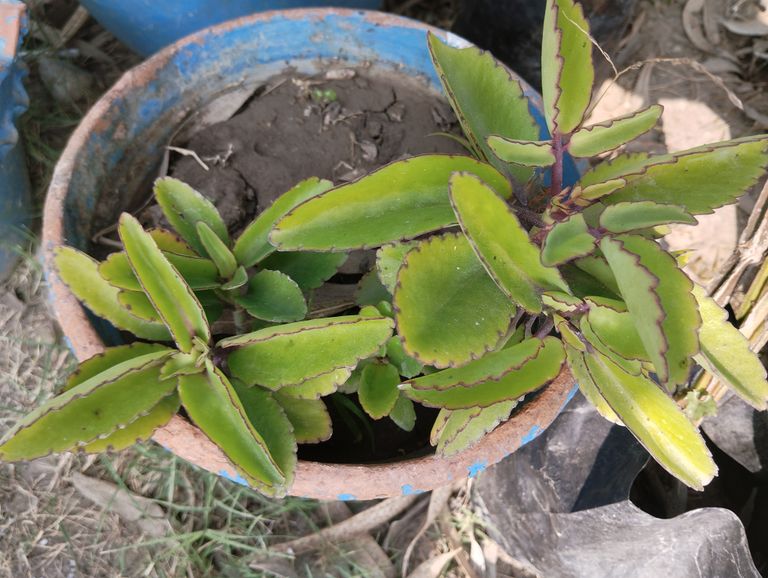
How to Grow and Care for Patharkuchi Kalanchoe Flowers on Your Rooftop.
Patharkuchi, also known as Kalanchoe, is a popular flowering plant in tropical and subtropical regions. Its low-maintenance nature, vibrant blossoms, and medicinal properties make it a favorite among gardeners. Growing Patharkuchi on your rooftop can transform the space into a vibrant, serene retreat. This blog provides a comprehensive guide on how to plant, nurture, and care for Patharkuchi flowers on your rooftop garden.
Why Choose Patharkuchi for Your Rooftop Garden?
- Low Maintenance: Patharkuchi thrives in minimal care and is drought-tolerant.
- Aesthetic Appeal: Its colorful flowers add beauty to any space.
- Medicinal Benefits: Leaves are used in traditional medicine for treating wounds, kidney stones, and inflammation.
- Compact Size: Perfect for small rooftop gardens or container planting.
Steps to Plant Patharkuchi on Your Rooftop
- Select the Right Location
Patharkuchi plants require plenty of sunlight to thrive. Choose a sunny spot on your rooftop that gets at least 4–6 hours of direct sunlight daily.
- Choose the Right Containers
Use small to medium-sized pots with good drainage.
Terracotta or ceramic pots are ideal as they prevent waterlogging.
Ensure the container has at least one drainage hole to prevent root rot.
- Prepare the Soil Mix
Patharkuchi prefers well-draining soil. Prepare the potting mix as follows:
50% garden soil
30% sand
20% compost or organic manure
This mix ensures proper aeration and provides the nutrients needed for growth.
- Planting the Patharkuchi
Take a healthy leaf or stem cutting from an existing Patharkuchi plant.
Let the cutting dry for a day to prevent rot.
Plant the cutting in the prepared soil mix, burying it about 2 inches deep.
Water lightly and keep the pot in partial shade for a week before moving it to full sunlight.
Caring for Patharkuchi Plants
- Watering
Water the plant only when the topsoil feels dry.
Avoid overwatering as it can cause root rot.
- Fertilizing
Feed the plant with a balanced fertilizer once every 4–6 weeks during the growing season (spring and summer).
Use a diluted liquid fertilizer to avoid over-fertilization.
- Pruning
Remove dead or yellow leaves regularly to encourage new growth.
Pinch off the tips of the plant to maintain a bushy shape.
- Pest and Disease Management
Watch for common pests like aphids and mealybugs.
Treat infestations with neem oil or an organic insecticidal soap.
Avoid waterlogging to prevent fungal diseases.
How to Encourage Blooming
Patharkuchi flowers usually bloom in winter or early spring. To ensure abundant blooms:
- Provide consistent sunlight.
- Reduce watering slightly during the flowering season.
- Avoid nitrogen-heavy fertilizers, as they promote leaf growth over flowers.
Creative Rooftop Garden Ideas with Patharkuchi
- Hanging Baskets: Grow Patharkuchi in hanging pots to create a cascading floral effect.
- Vertical Garden: Use wall-mounted planters for a green wall filled with colorful blooms.
- Mix and Match: Pair Patharkuchi with other succulents for a diverse rooftop garden.
- Mini Garden Pots: Use decorative pots to grow Patharkuchi as a centerpiece on tables.
Benefits of Growing Patharkuchi on the Rooftop
- Eco-Friendly Space: Rooftop gardens reduce urban heat and improve air quality.
- Stress Relief: Gardening is therapeutic and enhances mental well-being.
- Energy Efficiency: Plants help insulate the building, reducing energy consumption.
Final Thoughts
Patharkuchi is an excellent choice for rooftop gardens due to its beauty, resilience, and medicinal value. With minimal effort, you can create a thriving garden that adds charm and utility to your rooftop. Start planting today and enjoy the vibrant blooms of Patharkuchi year-round.
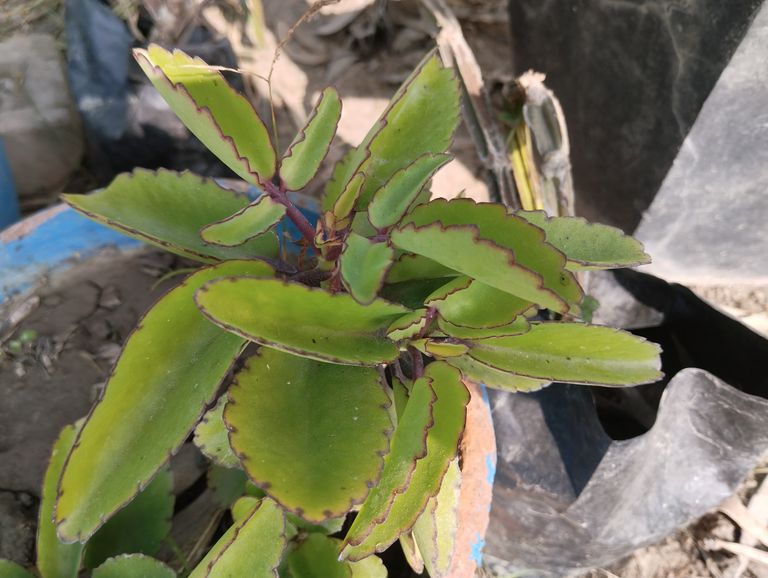
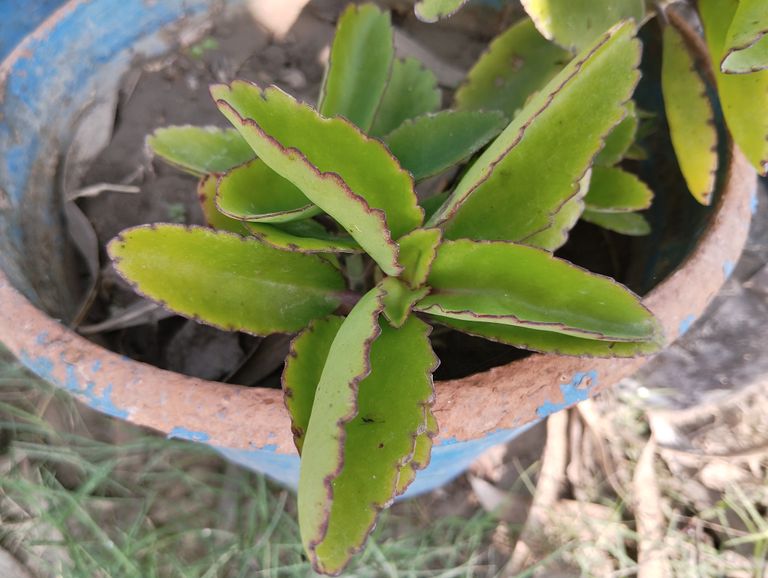
Patherkuchi Plant: Features, Benefits, and Uses
The Patherkuchi plant, scientifically known as Bryophyllum pinnatum and commonly referred to as the "Miracle Leaf" or "Air Plant," is a medicinal herb widely found in tropical and subtropical regions. It holds significant importance in traditional medicine, particularly in Ayurveda and folk remedies. Known for its ability to grow even in harsh conditions, the Patherkuchi plant is admired for its remarkable therapeutic properties and ecological adaptability.
Botanical Description
The Patherkuchi plant belongs to the Crassulaceae family and is characterized by its unique features:
- Appearance:
Succulent, thick, fleshy leaves with scalloped edges.
The leaves are bright green, sometimes with a hint of reddish-purple on the margins.
- Growth:
It is a perennial plant that grows up to 1-2 meters in height.
The plant propagates easily through its leaves, where small plantlets develop along the edges.
- Flowers:
Bell-shaped, greenish-pink or reddish flowers bloom in clusters, often appearing during cooler seasons.
Medicinal Properties of Patherkuchi
The Patherkuchi plant is valued for its medicinal properties, which stem from its bioactive compounds such as flavonoids, glycosides, alkaloids, and organic acids. These compounds contribute to its numerous health benefits:
- Anti-inflammatory:
Reduces inflammation and soothes swelling, making it useful for skin irritations and joint pain.
- Antimicrobial:
Effective against various bacterial, viral, and fungal infections.
- Antioxidant:
Fights free radicals, thereby reducing oxidative stress and promoting overall health.
- Diuretic:
Aids in flushing out toxins by increasing urine production, beneficial for kidney health.
- Wound Healing:
Speeds up the healing process for cuts, burns, and wounds.
Health Benefits of Patherkuchi
- Kidney Stones:
Patherkuchi juice is traditionally used to dissolve kidney stones and prevent recurrence.
- Respiratory Issues:
Provides relief from coughs, asthma, and other respiratory ailments due to its soothing and anti-inflammatory properties.
- Digestive Health:
Improves digestion, alleviates constipation, and reduces acidity.
- Immune Booster:
Enhances immunity and strengthens the body’s resistance against infections.
- Skin Care:
Treats acne, rashes, and minor burns. The plant's antimicrobial properties prevent infections and promote clear skin.
- Blood Pressure Regulation:
Helps in controlling high blood pressure by reducing stress on the cardiovascular system.
Traditional Uses of Patherkuchi
In various cultures, the Patherkuchi plant has been a part of traditional medicine for centuries. Some common uses include:
Leaf Juice: Extracted from fresh leaves, it is consumed to treat kidney stones, ulcers, and digestive issues.
Poultice: Crushed leaves are applied directly to wounds, boils, or insect bites for quick healing.
Infusion: The leaves are boiled to prepare herbal tea, which is consumed for respiratory and immune support.
How to Use Patherkuchi
- For Kidney Stones:
Extract the juice from fresh leaves and mix it with water. Consume 1-2 tablespoons daily.
- For Skin Problems:
Crush the leaves to make a paste and apply it directly to the affected area.
- For Cough and Cold:
Boil the leaves in water with honey and ginger to prepare a soothing herbal tea.
- For Wounds and Burns:
Rub the fleshy part of the leaf directly on the wound to promote healing.
Ecological Importance
Apart from its medicinal benefits, Patherkuchi plays a significant ecological role:
Air Purification: Absorbs harmful pollutants, improving air quality.
Soil Erosion Control: Its dense growth prevents soil erosion in areas with loose soil.
Drought Tolerance: Requires minimal water, making it ideal for arid and semi-arid regions.
Precautions and Side Effects
While Patherkuchi is generally safe, excessive consumption may lead to:
Nausea or stomach discomfort.
Allergic reactions in sensitive individuals.
Interaction with certain medications.
It is advisable to consult a healthcare professional before using it, especially for pregnant women or individuals with underlying health conditions.
The Patherkuchi plant is truly a gift of nature, offering a plethora of health benefits and ecological advantages. Its easy cultivation, versatile applications, and traditional significance make it a valuable addition to any medicinal garden. Whether you’re looking for a natural remedy for common ailments or a resilient plant to brighten up your space, Patherkuchi is an excellent choice.
With its remarkable healing properties and sustainable growth, the Patherkuchi plant continues to be celebrated as a miracle herb in modern and traditional medicine alike.
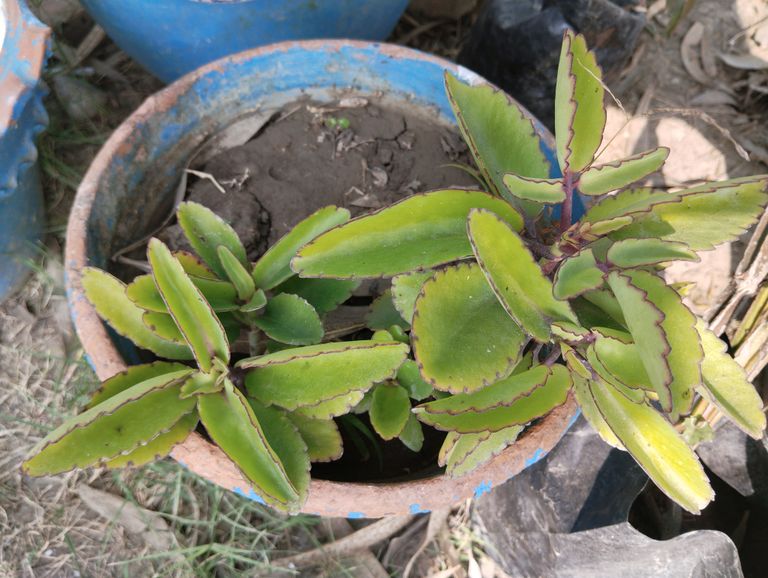
Benefits of Patharkuchi Leaves: A Natural Remedy
Patharkuchi, also known as Bryophyllum pinnatum, is a medicinal plant that has been used in traditional medicine for centuries. Commonly referred to as the "Miracle Leaf" or "Life Plant," it is renowned for its healing properties and versatility in treating various ailments. This article explores the numerous benefits of Patharkuchi leaves and how they can contribute to your health and well-being.
- Promotes Wound Healing
Patharkuchi leaves are widely used for their ability to accelerate wound healing. The leaves contain compounds that have antimicrobial and anti-inflammatory properties, which help in reducing infection and promoting tissue repair. Applying crushed Patharkuchi leaves directly to a wound can aid in quicker healing.
- Aids in Treating Kidney Stones
One of the most well-known uses of Patharkuchi leaves is in the treatment of kidney stones. The plant contains diuretic properties that help in flushing out excess calcium and other minerals that form kidney stones. Consuming the juice of Patharkuchi leaves with water can alleviate symptoms and even dissolve small stones over time.
- Helps Manage Respiratory Disorders
Patharkuchi leaves are effective in managing respiratory issues such as cough, asthma, and bronchitis. The leaves act as a natural expectorant, helping to clear mucus from the respiratory tract. Boiling the leaves in water and drinking the extract can relieve symptoms and improve breathing.
- Regulates Blood Pressure
The plant is known for its ability to regulate blood pressure levels. The potassium content in Patharkuchi leaves helps in relaxing blood vessels, thereby reducing hypertension. Regular consumption of Patharkuchi leaf extract can help maintain cardiovascular health.
- Relieves Stomach Disorders
Patharkuchi leaves are beneficial for treating digestive issues such as ulcers, diarrhea, and constipation. The anti-inflammatory properties of the leaves help soothe the stomach lining, while their laxative effect aids in regular bowel movements. Drinking a decoction made from the leaves can provide relief from gastrointestinal discomfort.
- Supports Skin Health
Patharkuchi leaves are a natural remedy for various skin problems, including rashes, boils, and minor burns. The antibacterial and antifungal properties of the leaves help in preventing infections and promoting clear skin. Applying the leaf paste directly to the affected area can soothe irritation and enhance healing.
- Strengthens Immunity
The leaves are rich in antioxidants, which help in boosting the immune system. Regular intake of Patharkuchi leaf juice can enhance the body’s ability to fight infections and reduce oxidative stress.
- Reduces Inflammation and Pain
Patharkuchi leaves are effective in alleviating pain and inflammation. They contain bioactive compounds that work as natural analgesics. Whether it’s joint pain, muscle soreness, or swelling, applying the crushed leaves to the affected area can provide relief.
- Manages Diabetes
Research suggests that Patharkuchi leaves can help regulate blood sugar levels. The hypoglycemic effect of the plant makes it beneficial for individuals with diabetes. Consuming the juice or extract of the leaves can help maintain healthy glucose levels.
- Detoxifies the Body
Patharkuchi leaves act as a natural detoxifier, helping to cleanse the body of toxins. They promote healthy liver function and improve kidney performance, ensuring the efficient removal of waste products from the body.
How to Use Patharkuchi Leaves
Juice: Extract the juice of fresh Patharkuchi leaves and mix it with water. Consume it on an empty stomach for maximum benefits.
Paste: Crush the leaves into a paste and apply it directly to wounds, burns, or skin irritations.
Decoction: Boil the leaves in water to prepare a herbal tea. Drink it warm to relieve cough, kidney stones, or stomach issues.
Precautions
While Patharkuchi leaves offer numerous health benefits, it is essential to use them in moderation. Overconsumption may lead to adverse effects, such as diarrhea or low blood pressure. Pregnant and breastfeeding women should consult a healthcare professional before using Patharkuchi leaves.
Conclusion
Patharkuchi leaves are a treasure trove of health benefits, offering a natural solution for various ailments. Whether you’re looking to treat wounds, improve digestion, or manage chronic conditions like diabetes and hypertension, this miracle plant can be a valuable addition to your herbal remedies. Always consult a healthcare provider to ensure safe and effective use.
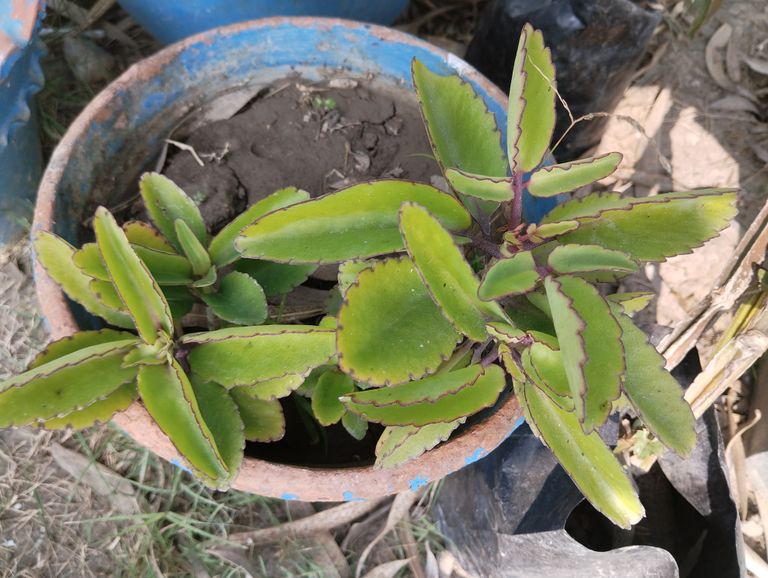
Medicinal Benefits of Patharkuchi Leaves: A Natural Healer
Patharkuchi (scientifically known as Bryophyllum pinnatum) is a well-known medicinal plant widely used in traditional medicine. Its leaves possess various therapeutic properties that contribute to overall health and wellness. In this blog, we will explore the medicinal benefits of Patharkuchi leaves and their uses in detail.
Introduction to Patharkuchi
Patharkuchi, also called the "Miracle Leaf" or "Life Plant," belongs to the Crassulaceae family. It is a succulent herb found in tropical and subtropical regions. The plant is recognized for its thick, fleshy leaves that store water, making it drought-resistant. Patharkuchi is easy to grow and thrives in almost any environment, making it a favorite for home gardens.
Nutritional Composition of Patharkuchi Leaves
Patharkuchi leaves are rich in bioactive compounds, including:
Flavonoids
Tannins
Alkaloids
Glycosides
Phenolic compounds
These compounds give the leaves their antioxidant, anti-inflammatory, and antimicrobial properties.
Medicinal Properties of Patharkuchi Leaves
Patharkuchi leaves are renowned for their wide range of medicinal benefits, including:
- Kidney Stone Treatment
One of the most popular uses of Patharkuchi leaves is in the treatment of kidney stones. Consuming the juice extracted from these leaves helps dissolve stones and prevent their formation. The diuretic properties of the plant assist in flushing out toxins and excess minerals from the kidneys.
- Wound Healing
The anti-inflammatory and antiseptic properties of Patharkuchi leaves make them effective for treating wounds, cuts, and burns. Applying crushed leaves directly to the affected area speeds up the healing process by reducing pain and preventing infections.
- Digestive Health
Patharkuchi leaves are beneficial for the digestive system. They help in:
Reducing acidity and heartburn.
Alleviating symptoms of stomach ulcers.
Promoting healthy bowel movements.
Drinking Patharkuchi leaf juice or tea can relieve constipation and improve overall digestion.
- Respiratory Health
The plant is widely used to treat respiratory problems such as asthma, cough, and cold. Its expectorant properties help in clearing mucus from the respiratory tract, providing relief from congestion.
- Anti-Diabetic Effects
Patharkuchi leaves are known to regulate blood sugar levels, making them a natural remedy for managing diabetes. Regular consumption can help stabilize glucose levels in the bloodstream.
- Anti-Inflammatory and Pain Relief
The anti-inflammatory compounds in Patharkuchi leaves reduce swelling and alleviate pain. They are commonly used to treat arthritis, joint pain, and other inflammatory conditions.
- Antimicrobial Properties
Patharkuchi leaves exhibit strong antimicrobial properties, which help combat bacterial, viral, and fungal infections. They are effective against skin infections, urinary tract infections (UTIs), and more.
- Liver Health
Patharkuchi leaves are a natural detoxifier. They aid in cleansing the liver and improving its function. Consuming these leaves regularly can help prevent liver-related ailments.
- Skin Care
The juice of Patharkuchi leaves can be used as a natural remedy for various skin problems, including:
Acne
Eczema
Psoriasis
It soothes irritated skin, reduces inflammation, and promotes a healthy complexion.
- Boosts Immunity
Regular consumption of Patharkuchi leaves strengthens the immune system, making the body more resistant to infections and diseases.
How to Use Patharkuchi Leaves
Patharkuchi leaves can be used in several ways depending on the ailment:
- Juice
Extract the juice by crushing fresh leaves. Mix with water and consume on an empty stomach for kidney health and detoxification.
- Poultice
Crush the leaves into a paste and apply directly to wounds, burns, or skin infections for quick relief.
- Tea
Boil the leaves in water to prepare a herbal tea. This is excellent for respiratory and digestive health.
- Oil
Infuse Patharkuchi leaves in oil and apply to the skin for treating acne, rashes, or joint pain.
- Salad
Fresh leaves can be added to salads or consumed raw for their nutritional benefits.
Precautions and Side Effects
While Patharkuchi leaves are generally safe, excessive consumption may lead to:
Diarrhea
Nausea
Pregnant and breastfeeding women should consult a healthcare professional before using Patharkuchi leaves. Always use the plant in moderation and under guidance if you are on medication.
Patharkuchi leaves are a powerhouse of medicinal benefits. From treating kidney stones to boosting immunity, this versatile plant is a natural healer. Incorporating Patharkuchi leaves into your daily routine can help maintain overall health and well-being. As with any natural remedy, moderation and proper usage are key to reaping the full benefits of this incredible plant.